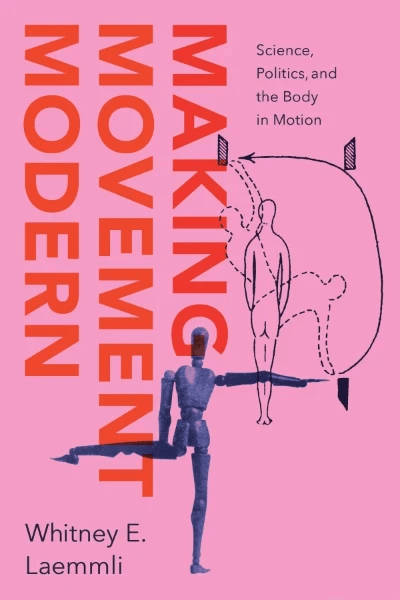

Whitney E. Laemmli
Historian of science, technology,
medicine and the body.

I am a historian of science and technology and an assistant professor in the Department of Social Sciences and Cultural Studies at the Pratt Institute. My work focuses on the study and control of the human body, and my book, Making Movement Modern is forthcoming with the University of Chicago Press. It explores how and why human movement became a central object of technoscientific, political, and popular concern over the course of the twentieth century.
I've been honored to receive fellowships and awards from the SSRC, the ACLS/Mellon Foundation, the History of Science Society's Forum for the History of the Human Sciences, the Society for the History of Technology, and the NYU Center for Ballet and the Arts. I received my PhD from the University of Pennsylvania and spent 2016-2019 as a member of Columbia University’s Society of Fellows. I also spent the 2021-2022 academic year as an Andrew W. Mellon Foundation Member at the Institute for Advanced Study and was previously an assistant professor in the Department of History at Carnegie Mellon University.
Particular areas of ongoing research interest include the history of information and data; religion and technology; the twentieth century life and human sciences; medicine and mind; and art and technoscience.


Research
A description of my forthcoming book, Making Movement Modern: Science, Politics and the Body in Motion, can be found below. Other publications and projects have investigated the material history of the ballet pointe shoe, the sexual rehabilitation of paraplegic WWII veterans, and the relationship between modern technology and religion. I am also currently at work on a new book which explores a contentious set of twentieth and twenty-first century debates about whether the whole body--and not merely the well-studied brain--played a role in generating, storing, and communicating thoughts and emotions

Making Movement Modern
Making Movement Modern: Science, Politics, and the Body in Motion (University of Chicago, forthcoming) is a history of how and why human bodily movement became a key subject of technoscientific, political, and popular concern over the course of the twentieth century. Central to this story is “Labanotation,” a tool for recording movement on paper devised in the 1920s by the German choreographer Rudolf Laban. Motivated by an engagement with the work of physiologists, biologists, and neurologists, Laban was convinced that movement was the most important influence on the human organism and sought to employ notation to manage its effects. The book follows Labanotation—and the scientific ideas about human physiological response accompanied it—from its origins in the ferment of Weimar culture to its role in the Nazi state to its eventual life in the factories, hospitals, and corporate boardrooms of postwar Britain and the United States. There, it was used as part of programs to excite exhausted assembly line workers, identify and treat people with mental illnesses, screen white-collar job applicants, and re-make ideas about racial difference. By the 1980s, movement notation had gone “digital”: incorporated into a variety of computerized systems for assessing and replicating human movement. To many of these systems’ developers, Labanotation was simply a useful tool for gathering data. Their decision to deploy it, however, embedded in these new technologies assumptions about movement and its meaning first advanced nearly a century earlier.
Laban's Weimar-era efforts might initially seem worlds away from the mid-century corporation or the contemporary robotics lab. My research, however, illuminates the ties—both intellectual and material—that bound these disparate sites together. In doing so, the book provides a new and newly synthetic account of human movement and its meaning—for scientists, for engineers, for artists, for patients, for citizens—across the twentieth century.
Pre-order here:
https://press.uchicago.edu/ucp/books/book/chicago/M/bo257654868.html
Upcoming and Recent Events
- “Making Movement Modern: Science, Politics, and the Body in Motion,” in Energy Flows: Performance, Modernity, and the Histories of Science and Technology Lecture Series, Frei Universität Berlin, June 2025.
- The Measured Gesture: The Science of Movement from Weimar Germany to Corporate America,” Science in Human Culture Program, Northwestern University, November 2024.
- "The Choreography of Everyday Life: Dance Notation and the Politics of Movement,” American Historical Association, January 2025.
- Workshop, “Hopes and Fears: Emotions and Decision-Making in Historical Analysis of Science, Medicine, and Technology,” Department of History of Science and Technology, Johns Hopkins University, October 2024.
- “The Measured Gesture: Tracking Bodies in Motion,” Yale Architecture Forum, Yale University,
October 2024. - "Psychiatry, Medicine, and Movement at Mid-Century,” Richardson Seminar on the History of Psychiatry, DeWitt Wallace Institute of Psychiatry at Weill Cornell Medicine, December 2023.
- Commentator, “Unity and Interdisciplinarity in the Postwar Sciences,” History of Science Society, November 2023.
- “The Measured Gesture,” University of Chicago, Committee on the Conceptual and Historical Studies of Science, October 2023.
- “Is My Robot Happy? A History of Movement and Emotion in People and Machines,” University of Toronto, BMO Lab for Creative Research in the Arts, Performance, Emerging Technologies and AI, February 2023.
- "Sensibility Through Technology,” Invited Workshop Participant, The Cambridge History ofTechnology, Max Planck Institute for the History of Science, Department III, Berlin, Germany, January 2023.
- Roundtable participant, “History of Technology: State of the Field,” Celebrating 50 Years of Scholarship, Department of the History and Sociology of Science, University of Pennsylvania, October 2022.
- “‘The Lilt in Labour’: Labanotation and the British Industrial Imagination,” Keynote, Culture visuelle du geste efficace et danses de société (1910–1940), National Institute for Art History, Paris, France, September 2022.
- “Making Movement Modern: Science, Politics, and the Body in Motion,” in Energy Flows: Performance, Modernity, and the Histories of Science and Technology Lecture Series, Frei Universität Berlin, June 2025.
Selected Publications
- “Taylorism Transfigured: Industrial Rhythm and the British Factory,” and "Editors' Introduction: Pious Technologies and Secular Designs," Grey Room 88 (2022).
- “How to Capture Movement,” in Historical Studies in the Natural Sciences 52, no. 1 (2022).
- “The Living Record: Alan Lomax and the World Archive of Movement,” in History of the Human Sciences 31 (December 2018), Special Issue on “The Total Archive: Data, Subjectivity, Universality.”
- “Paper Dancers: Art as Information in Twentieth Century America” in Information and Culture 52 (January 2017).
- "Alan Lomax and the Temple of Movement." Limn 6: The Total Archive, March 2016.
- “Half a Man: The Symbolism and Science of Paraplegic Impotence in World War II America,” in Osiris 30, “Scientific Masculinities,” ed. Robert A. Nye and Erika Lorraine Milam (October 2015). With Beth Linker.
- “A Case in Pointe: Romance and Regimentation at the New York City Ballet,” in Technology and Culture 56 (January 2015).
Winner of the 2018 Abbot Payson Usher Prize from the Society for the History of Technology. - Review of The Reason I Jump by Naoki Higashida, Introduction and Translation by David Mitchell, Somatosphere, 24 October 2014.



- “Taylorism Transfigured: Industrial Rhythm and the British Factory,” and "Editors' Introduction: Pious Technologies and Secular Designs," Grey Room 88 (2022).
Download Curriculum Vitae.
Send Me a Message!
Copyright 2015





